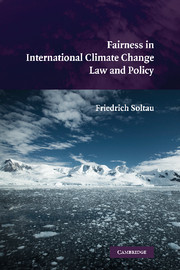Book contents
- Frontmatter
- Contents
- List of Abbreviations and Acronyms
- Acknowledgments
- 1 Fairness in International Climate Law and Policy
- 2 The Science of Climate Change and the Energy Challenge
- 3 Development of the International Climate Change Regime
- 4 Theoretical Aspects of Fairness
- 5 Fairness in the Climate Change Regime
- 6 Evaluation of Proposals for Future Climate Policy
- 7 Conclusion
- Bibliography
- Index
- References
6 - Evaluation of Proposals for Future Climate Policy
Published online by Cambridge University Press: 24 December 2009
- Frontmatter
- Contents
- List of Abbreviations and Acronyms
- Acknowledgments
- 1 Fairness in International Climate Law and Policy
- 2 The Science of Climate Change and the Energy Challenge
- 3 Development of the International Climate Change Regime
- 4 Theoretical Aspects of Fairness
- 5 Fairness in the Climate Change Regime
- 6 Evaluation of Proposals for Future Climate Policy
- 7 Conclusion
- Bibliography
- Index
- References
Summary
INTRODUCTION
There are a number of ideas on how to design the next phase of the climate regime. While some proposals are variations on basic themes, a recent survey of approaches for advancing international climate policy counted 40 proposals. This chapter outlines the features of a number of the main proposals and assesses them according to fairness principles. Accordingly, this chapter begins with an overview of the various assessment criteria for a future climate change agreement – and the burden-sharing rules they contain – which reflect general principles of fairness. Although fairness is the subject of this study, it is only one among a range of criteria by which to assess climate policy proposals. Consistency with principles of equity and fairness is of limited use if the proposal at issue is politically unacceptable and of limited feasibility in policy terms. Accordingly, this chapter also seeks to evaluate the proposals against a number of assessment criteria drawn from the literature on the subject. The chapter sets out to do two things: first, it sets out a set of policy criteria for evaluating climate change proposals; second, it assesses a small but representative sample of actual proposals in light of both fairness principles and the set of policy criteria.
Earlier, it was concluded that no single account of equity or fairness could satisfy the demands placed on it by parties with competing conceptions of what is fair and just and divergent material interests.
- Type
- Chapter
- Information
- Fairness in International Climate Change Law and Policy , pp. 228 - 260Publisher: Cambridge University PressPrint publication year: 2009



